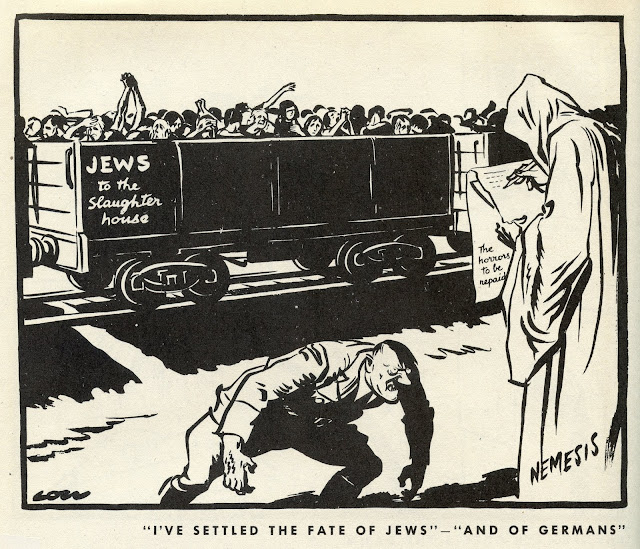To draw a hostile war lord as a horrible monster is to play his game. What he doesn't like is being shown as a silly ass.Low was second to none at depicting tyrants as silly asses:
Low was so effective at getting under Hitler's skin that prior to WW II, the Nazi government lodged a formal protest about Low's drawings.
Despite Low's rule about not dignifying tyrants by drawing them as "horrible monsters," sometimes he couldn't resist giving a tyrant the full "monster" treatment. When the war became too horrifying, his outrage overcame his resolution:
Yet, Low never lost artistic control. He recognized that to make the most powerful statement he could not abandon restraint; a picture overcome by passion and emotion is usually less potent.
Look how thoughtfully Low constructed the wonderful drawing above. To draw the worst creature imaginable, many artists might get carried away and make Hitler a literal monster with blood and fangs and claws. But with consummate skill, Low transforms Hitler into a beast primarily by giving him a stooped, ape-like posture.
 |
| Keen powers of observation at work: Low didn't need to resort to fur or tentacles to make a monster; all it took was splayed legs, hunched shoulders, dangling arms and effective shadows. |
Similarly, look at how simply yet carefully Low evokes those victims in the cattle car. They are a sea of humanity, yet each sufferer has individual character.
The more extreme an artist decides to treat a subject, the more talent is required to keep the drawing from going off the rails.
As Peter Viereck reminded us, "Art, being bartender, is never drunk."







7 comments:
fascinating stuff, a very talented man, although his "orders and decoration" suffer from "well meaning racism"
I consider political painting, as it is generally practiced, to be an inferior grade of art. That is because the treatment of subject matter tends to be binary -- worshipfulness or scathing denunciation. Subject matter tends to distract from any artistic qualities.
You touched on the second problem in this post: depicting what the artist hates as monstrous.
Editorial cartoonists operate in a different realm because they are expected to praise or condemn, something expected by viewers of their work. Which is why I regard that field as a different species from political painting. I found your take on Low interesting, never having thought about political cartoons that way.
So why not start a little game of Pigeonhole That Cartoonist.
I nominate the overrated (in my opinion) Herblock as one who tended to wear his dislikes on his sleeve (recall his five o'clock shadowed Richard Nixon).
On the making subjects look silly side, I nominate Jeff MacNelly for his treatment of Jimmy Carter and Michael Ramirez for his Obama.
Low was awesome.
Low was serviceable.
Anonymous-- well, perhaps. The "Lord of Africa" figure was supposed to be Benito Mussolini, the white Italian dictator who prided himself on being a flower of civilization but who ruthlessly invaded Ethiopia. I think few pictures could enrage him as much as being depicted with a bone in his hair, preening over a silly sash designating him the Lord of Africa.
Donald Pittenger-- I agree, political cartoonists are by definition advocates, a job often more conducive to polemic rather than art. The cartoonist Oliphant tried to avoid meeting politicians because it would be harder to hate them. The cartoonist Richard Thompson declined the job of Herblock's replacement because he didn't think he was capable of harboring the necessary grudges. I also agree with you about Herblock; I think he was a third rate artist. As far as I can tell, his reputation must be based upon his longevity and the topics he covered. I think Jeff MacNelly's Jimmy Carter was brilliantly devastating but I am less impressed with Michael Ramirez"s Obama.
MORAN-- That seems to be the consensus, although see Kev Ferrara's view below you.
Kev Ferrara-- is there another WW II political cartoonist that you think was better? Are you a Bill Mauldin fan? Arthur Szyk, perhaps?
Anybody who helped the cause was okay by me.
I mentioned Ramirez because, while he is opposed to Obama's politics, he does not depict Obama as monstrous, but instead as silly. However, I do find his caricature perplexing -- I couldn't identify the subject were I ignorant of Ramirez's work.
What he is good at is caricaturing airplanes, cars and similar stuff. MacNelly was also good at that: Think those 1957-vintage DeSotos in his "Shoe" comic strip.
Post a Comment